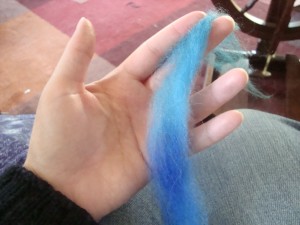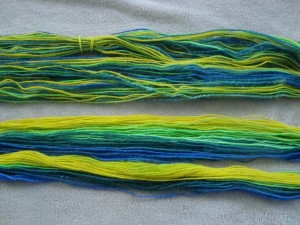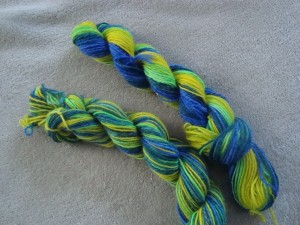…makes Jack a dull boy, right?
Since most everyone seemed to be leaning toward play (and since I had some pretty strong leanings in that direction myself), I decided to try spinning the second half of the gradient as a short repeat yarn.
As instructed, I kept it simple. No overthinking…not even a bit. (Who me? Overthink? Never!)
I split the top along its full length, making 10 very narrow strips.
Then I spun them, one after the other until I ran out. (I was also careful to keep the cats out of the pile while I was spinning. This was critical, and proved to require more attention than I expected. Apparently lots of little strips of fiber = warm nest in the mind of a cat.)
I chain plied the singles like I did for the first skein, and ended up with about 2 yard lengths of each color (compared to about 20 yards per color in the previous skein). You can see the difference in the color distribution here:
And the two skeins together:
True to form, I like the long repeat version better in the skein, but I’m really not sure which I would prefer in the knitting.
I’d started out spinning this yarn expecting it to become a pair of socks, so I spun a (slightly heavy) sock weight. But then I was thinking about it, and I wasn’t sure that I wanted that long a gradient along the length of just one sock. That’s where the possibility generator kicked in and suggested that shorter repeats would be nice, so that there would just be a few rounds of each color in repeating stripes.
For a sock, I think I’d much prefer the shorter repeat version. I’d guess that there would be 3, maybe 4 rows per color, and then the colors will repeat every half inch or so, for the full length of the sock.
If I were to knit this into a shawl or a larger garment, then the long repeat version would look really good striped with a darker solid color. Of course, you could also alternate sections of long and short repeats to get all kinds of interesting combinations, too.
Because this is me, I no longer want to use this yarn for socks. My brain somehow manages to take a sharp left turn every time I sit down to think about knitting socks. Sweaters and shawls and bigger things are just much more exciting for some reason. (Also, I like my socks to match, which might be hard with this yarn now.)
Last night, I was having visions of a stranded colorwork bag, with the bright yarn worked on a dark blue background. But today, a mischievous little voice is suggesting that they would look very nice woven.
I said I didn’t overthink the spinning. I didn’t promise anything at all about the using of the yarn.
(Of course, all these ideas just mean more decisions, but that woven idea is pretty sticky. I think it might win.)


